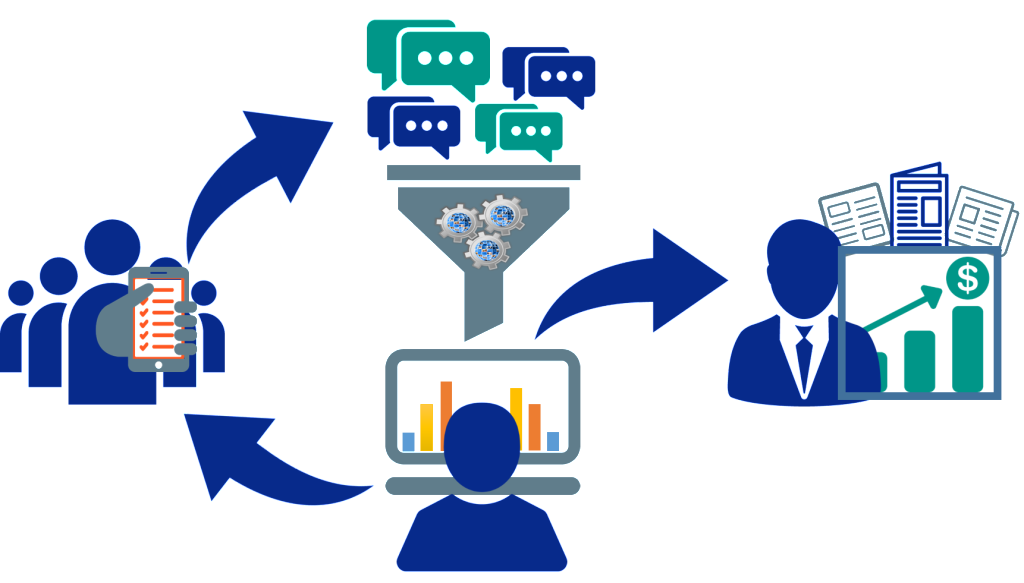Learning
The Power of Charts in Survey Data Analysis

In today’s data-centrist world, surveys play a pivotal role in gathering valuable information and insights from diverse audiences. However, analyzing raw survey data analysis can be a challenging endeavor, as it often involves dealing with vast amounts of information in various formats.
To unlock the full potential of survey data and gain meaningful insights, data visualization through charts emerges as an indispensable tool. In this blog, we will explore the best charts to analyze survey data effectively and reveal valuable insights that drive informed decision-making.
What is Survey Data Analysis?
Survey data refers to the information collected through surveys, which are structured questionnaires or interviews designed to gather specific data from a target group of individuals or respondents. Surveys are commonly used in various fields, including market research, social sciences, education, healthcare, and business, to gather insights, opinions, attitudes, and behaviors of the surveyed population.
Survey data can be collected using different methods, such as online surveys, phone interviews, face-to-face interviews, or paper-based questionnaires. The data obtained from surveys can be quantitative (numerical) or qualitative (descriptive or textual).
Types of Survey Data:
- Quantitative Data: Quantitative survey data consists of responses that are numerical and measurable. These responses are typically obtained from closed-ended questions, where respondents select from predetermined options. Examples of quantitative data include age, income, ratings on a scale, and the number of products purchased.
- Qualitative Data: Qualitative survey data involves non-numeric responses that provide descriptive information. This type of data is collected from open-ended questions, allowing respondents to express opinions, attitudes, and experiences in their own words. Qualitative data is valuable for gaining deeper insights into people’s thoughts and perceptions.
- Categorical Data: Categorical data is a subset of qualitative digital data that involves responses that can be grouped into categories. This data type often comes from questions with options like gender, ethnicity, education level, or product preferences.
- Ordinal Data: Ordinal data falls under qualitative data and represents responses with a natural order or ranking. Survey questions with options like “strongly disagree,” “disagree,” “neutral,” “agree,” and “strongly agree” generate ordinal data, where responses can be ranked based on the degree of agreement or preference.
- Interval Data: Interval data is a type of quantitative data where responses have a consistent interval or numeric difference between them. A common example is a rating scale from 1 to 10, where the difference between each rating is equal.
- Ratio Data: Ratio data is another form of quantitative data that possesses a meaningful zero point, representing the absence of the measured attribute. Examples include age, income, and the number of items purchased. Ratios between values have significance in this data type.
Understanding the different types of survey data is essential for effectively designing surveys, choosing appropriate analysis methods, and deriving meaningful insights from the collected responses. Researchers and analysts often employ various data visualization techniques to present survey findings in a comprehensible and actionable manner.
Types of Charts Used in Surveys
When analyzing survey data, the choice of charts plays a crucial role in effectively conveying insights and patterns to stakeholders. There are several types of charts commonly used in survey analysis, each catering to different types of data.
Bar Charts
Bar charts are ideal for displaying categorical data, where responses are grouped into distinct categories. They present data as vertical or horizontal bars, allowing for easy comparison of different categories and identifying the most common or preferred option.
Pie Charts
Pie charts are suitable for illustrating the distribution of categorical data as segments of a circle. They showcase the proportion of each category relative to the whole, making it easy to visualize percentages and relative sizes of responses.
Line Charts
Line charts are perfect for showing trends and changes over time, making them suitable for longitudinal survey data. They represent data as points connected by lines, highlighting patterns and fluctuations in responses.
Likert Scales
The Likert scale is a widely used survey rating system that measures respondents’ attitudes, opinions, or perceptions on a particular topic. It consists of a series of statements or questions, and respondents are asked to rate their level of agreement or disagreement using a predefined scale, typically ranging from 1 to 5 or 1 to 7. The scale’s anchors usually include options like “Strongly Disagree,” “Disagree,” “Neutral,” “Agree,” and “Strongly Agree.”
Histograms
Histograms are used for visualizing the distribution of numerical data. They group data into intervals or bins on the x-axis and display the frequency of responses on the y-axis, providing an overview of data spread and frequency of occurrence.
Scatter Plots
Scatter plots are employed to explore relationships between two numerical variables. Data points are plotted as individual dots, and the pattern of their arrangement can reveal correlations or patterns in the data.
Stacked Bar Charts
Stacked bar charts are an extension of bar charts, where the bars are divided into segments representing different subcategories. They are useful for comparing parts to the whole and examining how categories are composed of different elements.
Dot Plots
Dot plots are an effective way to display ordinal data, where responses have a natural order or ranking. Dots are placed along a single axis according to the corresponding response, showcasing their distribution.
Word Clouds
Word clouds visualize qualitative data by displaying frequently mentioned words or phrases in varying font sizes. They provide an at-a-glance view of common themes or sentiments from open-ended survey responses.
Each chart type serves a specific purpose in survey data analysis, and choosing the right one depends on the nature of the data and the insights you want to communicate. By employing appropriate charting techniques, survey analysts can effectively present survey findings and unlock valuable insights for better decision-making.
Data Visualization Tools for Survey Data Analysis:
- Tableau: Tableau is a powerful and popular data visualization tool that offers a user-friendly interface for analyzing and visualizing survey data. It allows users to create interactive dashboards, charts, and graphs to explore data in real-time, uncover patterns, and gain insights.
- Microsoft Power BI: Power BI is a versatile business intelligence tool that enables users to create dynamic visualizations from survey data. It offers a range of customizable charts, maps, and tables to present data in a compelling and interactive manner.
- Google Data Studio: Google Data Studio is a free cloud-based tool that seamlessly integrates with other Google products. It allows users to connect to various data sources, including survey data, and create interactive and shareable reports and dashboards.
- ChartExpo: ChartExpo is a data discovery and visualization tool that facilitates in-depth exploration of survey data. It has a vast variety of Survey charts that are not available on any other resource. It also provide a no-coding environment that allows users to create charts within few clicks.
- Plotly: Plotly is a web-based data visualization library that supports various programming languages like Python, R, and JavaScript. It offers a wide range of charts, including bar plots, line charts, heatmaps, and more, making it suitable for survey data analysis.
- Domo: Domo is a cloud-based platform that combines data visualization, business intelligence, and collaboration features. It allows users to create customized dashboards, interactive charts, and visualizations to gain actionable insights from survey data.
- Excel (Microsoft Office): Excel is a widely used spreadsheet tool that offers basic data visualization capabilities for survey data analysis. While not as robust as specialized data visualization tools, Excel can create simple charts, graphs, and pivot tables for initial data exploration.
Each of these data visualization tools comes with its unique features, strengths, and pricing models. Choosing the right tool for survey data analysis depends on the specific requirements, data complexity, and user preferences of the research or analysis project.
Conclusion
In conclusion, charts play a pivotal role in survey data analysis, enabling organizations to unlock hidden insights and make informed decisions. By carefully selecting the right chart types, customizing visualizations for clarity, and utilizing advanced techniques, businesses can harness the power of survey data to drive growth and success.
Embracing the art of data visualization empowers stakeholders to navigate through survey data with ease and unveil valuable insights that shape the future.






























